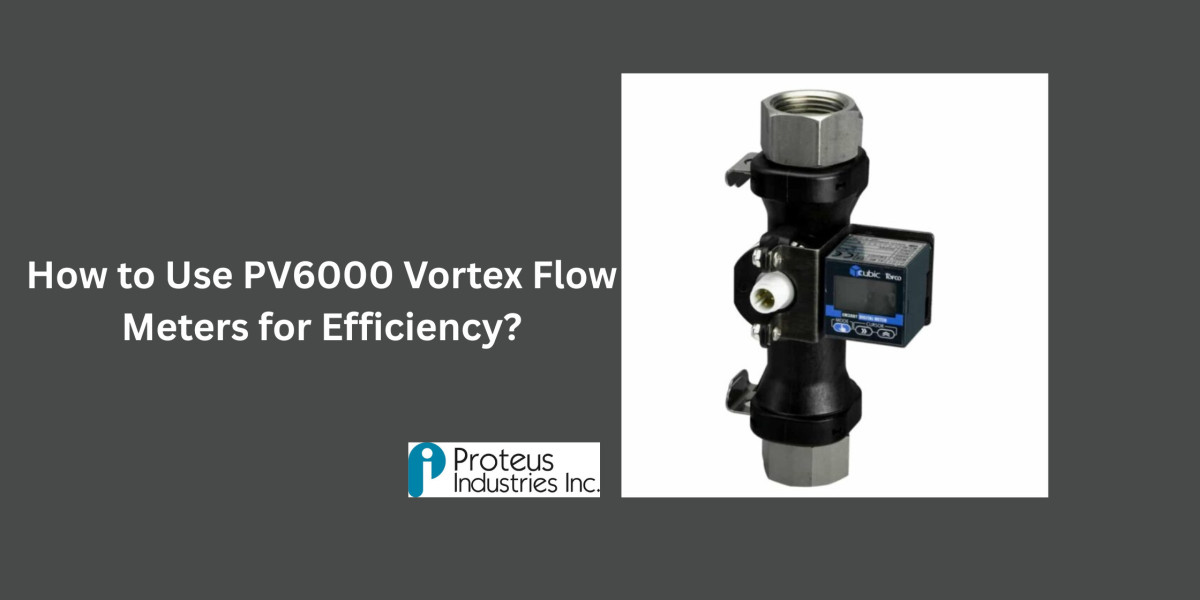In today's industrial landscape, accurate flow measurement is critical for operational efficiency, cost control, and regulatory compliance. The PV6000 series vortex flow meters have emerged as a leading solution for professionals seeking reliable, precise flow measurement across diverse applications. These advanced instruments combine cutting-edge vortex shedding technology with robust construction, making them ideal for measuring liquid, gas, and steam flow in challenging industrial environments. Understanding how to implement and optimise PV6000 vortex flow meters properly can significantly enhance your system's implementation while lowering operational costs and maintenance requirements.
Understanding Vortex Flow Measurement Technology
Vortex flow meters operate on the principle of vortex shedding, a natural phenomenon that occurs when fluid flows around a bluff body obstruction. The PV6000 series utilises this principle by placing a carefully designed shedder bar across the flow stream. As fluid passes around this obstruction, alternating vortices are created downstream, with the frequency of vortex formation being directly proportional to the fluid velocity.
The PV6000 meters detect these eddies using advanced piezoelectric sensors that convert the pressure fluctuations caused by vortex shedding into electrical signals. This technology provides exceptional accuracy across a wide range of flow rates, typically offering measurement precision within of the reading for liquids, gases, and steam.
The digital signal processing capabilities of the PV6000 series ensure stable measurements even in challenging conditions, such as those with vibration, temperature fluctuations, or pressure variations. This robust design makes them particularly suitable for industrial applications where dependability and accuracy are paramount.
Installation Best Practices for Maximum Efficiency
Proper installation is crucial for achieving optimal performance from PV6000 vortex flow meters. Site selection should prioritise locations with stable flow profiles, avoiding areas immediately downstream of pumps, valves, bends, or other flow disturbances. Generally, straight pipe runs of 15-20 pipe diameters upstream and five pipe diameters downstream provide optimal conditions for accurate measurement.
Pipe diameter matching is essential for wafer-style installations. Ensure the meter's internal diameter matches the adjacent piping to prevent flow disturbances. For insertion-type meters, verify proper probe positioning and secure mounting to prevent vibration-induced errors.
Electrical installation requires careful attention to grounding and shielding practices. Use appropriate conduit and cable types for the environmental conditions, ensuring all connections are properly sealed against moisture ingress. The PV6000 series typically requires power supplies, depending on the specific model configuration.
Calibration verification should be performed during installation using known reference standards or by comparing readings with portable flow measurement devices. This initial verification establishes baseline performance and ensures the meter is functioning within specified accuracy limits.
Configuration and Setup Procedures
The PV6000 series offers extensive configuration options to optimise performance for specific applications. The initial setup begins with the entry of fluid parameters, including the liquid type, density, viscosity, and operating temperature and pressure ranges. These parameters are critical for accurate flow calculation and temperature compensation.
Flow range configuration involves setting the minimum and maximum flow rates expected in your application. The PV6000's wide rangeability allows for conservative range setting while maintaining accuracy across the full operating spectrum. Output scaling can be configured to match existing control system requirements, whether analogue (4-20mA) or digital communication protocols.
Dampening settings help stabilise readings in applications with flow pulsations or system vibrations. The PV6000 series offers adjustable damping constants that can be optimised for specific process conditions. Too little damping may result in noisy signals, while excessive damping can slow response times unnecessarily.
Alarm and diagnostic features should be configured to provide early warning of potential issues. The PV6000 series can monitor parameters such as signal strength, temperature limits, and flow rate deviations, generating alerts before problems affect measurement accuracy.
Operational Optimisation Strategies
Maximising efficiency from PV6000 vortex flow meters requires ongoing attention to operational parameters and system conditions. Regular monitoring of key performance indicators helps identify optimisation opportunities and potential issues before they impact measurement accuracy.
Flow velocity optimisation is crucial for vortex meter performance. The PV6000 series operates most accurately within specific velocity ranges, typically 1-30 m/s for liquids and 8-80 m/s for gases. Operating outside these ranges may compromise accuracy or cause signal dropout. Pipe sizing and system design should target optimal velocity ranges for expected flow rates.
Signal quality monitoring provides valuable insights into meter performance. The PV6000 series typically includes signal strength indicators that help assess measurement reliability. Consistently low signal strength may indicate fouling, wear, or suboptimal operating conditions requiring attention.
Process condition stability has a significant impact on measurement accuracy. Maintaining stable temperature, pressure, and flow conditions within design parameters ensures optimal performance. Where process variations are unavoidable, ensure the meter's configuration accounts for these variations through appropriate compensation and range settings.
Maintenance and Troubleshooting Guidelines
Preventive maintenance is essential for sustained high performance from PV6000 vortex flow meters. Regular inspection schedules should include visual checks of external components, cable connections, and mounting hardware to ensure proper functioning. Internal inspection may be required periodically, depending on the application and fluid characteristics.
Sensor cleaning procedures vary by application but generally involve removing any buildup on the shedder bar and sensor surfaces. For liquid applications, chemical cleaning may be appropriate, while gas and steam applications typically require only mechanical cleaning. Always follow manufacturer guidelines for cleaning procedures and approved cleaning agents.
Calibration verification should be performed regularly, with the frequency determined by the application's criticality and regulatory requirements. Many installations benefit from annual calibration checks, though critical applications may require more frequent verification. The PV6000 series often includes diagnostic features that can help identify when calibration verification is needed.
Common troubleshooting scenarios include signal dropout, erratic readings, and output drift. Signal dropout often indicates inadequate flow velocity or excessive vibration, while erratic readings may suggest electrical interference or improper grounding. Output drift typically indicates sensor degradation or changes in process conditions affecting measurement accuracy.
Integration with Control Systems
The PV6000 series offers multiple communication options for seamless integration with modern control systems. Analogue 4-20mA outputs provide simple, reliable connections to basic control and monitoring systems, while digital communication protocols offer enhanced functionality and diagnostic capabilities.
HART communication enables bi-directional communication over the same wires used for analogue signalling, allowing for remote configuration and diagnostic access without the need for additional wiring. This capability significantly reduces commissioning time and enables remote troubleshooting and optimisation.
Modbus and Profibus protocols enable high-speed digital communication for advanced control systems that require rapid data exchange and comprehensive device diagnostics. These protocols support the transmission of multiple parameters, including flow rate, totalized flow, temperature, and diagnostic status information.
Data logging and trending capabilities help optimise system performance over time. By monitoring flow patterns, system operators can identify inefficiencies, optimise process conditions, and schedule maintenance activities more effectively. The PV6000 series typically supports internal data storage and transmission of historical data to supervisory systems.
Applications and Industry Use Cases
The versatility of PV6000 vortex flow meters makes them suitable for numerous industrial applications. Steam measurement in power generation and heating systems benefits from the meters' ability to withstand high temperatures and provide accurate measurements across a wide range of flows. The built-in temperature compensation ensures accuracy despite varying steam conditions.
Chemical processing applications leverage the meters' resistance to corrosive fluids and ability to handle varying process conditions. The PV6000 series can measure aggressive chemicals, solvents, and process fluids while maintaining long-term accuracy and reliability.
HVAC systems utilise these meters for monitoring chilled water, hot water, and steam distribution. The wide rangeability accommodates varying seasonal loads while maintaining accuracy during low-flow periods. This capability helps optimise energy consumption and identify system inefficiencies.
Oil and gas applications benefit from the meters' ability to handle hydrocarbon liquids and gases across a wide range of temperatures and pressures. The robust construction and explosion-proof certifications make them suitable for hazardous area installations.
Future-Proofing and Technology Upgrades
The PV6000 series features advanced technology that provides long-term value and adaptability to changing requirements. Firmware updates can often add new features or improve performance without hardware changes, protecting your investment over time.
Communication protocol flexibility ensures compatibility with evolving control system architectures. As industrial networks migrate to new standards, the PV6000 series can often accommodate these changes through configuration updates or the replacement of communication modules.
Diagnostic capabilities continue to expand through software enhancements, providing increasingly sophisticated monitoring and predictive maintenance capabilities. These features help extend equipment life and optimise performance throughout the meter's service life.
Conclusion
The PV6000 vortex flow meters represent a sophisticated solution for achieving optimal flow measurement efficiency across diverse industrial applications. Success with these instruments depends on proper installation, design, and ongoing optimisation practices. By following best practices for site selection, installation procedures, and operational monitoring, organisations can maximise the return on their flow measurement investment while ensuring long-term reliability and accuracy. Regular maintenance, proper system integration, and attention to operational parameters will help achieve the full potential of PV6000 vortex flow meters, ultimately leading to improved process efficiency, reduced costs, and enhanced operational performance.














